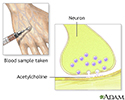Cholinesterase - blood
Acetylcholinesterase; RBC (or erythrocyte) cholinesterase; Pseudocholinesterase; Plasma cholinesterase; Butyrylcholinesterase; Serum cholinesterase
Serum cholinesterase is a blood test that looks at levels of 2 substances that help the nervous system work properly. They are called acetylcholinesterase and pseudocholinesterase. Your nerves need these substances to send signals.
Acetylcholinesterase is found in nerve tissue and red blood cells. Pseudocholinesterase is found primarily in the liver.
How the Test is Performed
A blood sample is needed. Most of the time blood is drawn from a vein located on the inside of the elbow or the back of the hand.
Drawn from a vein
Venipuncture is the collection of blood from a vein. It is most often done for laboratory testing.

How to Prepare for the Test
No special steps are needed to prepare for this test.
How the Test will Feel
You may feel slight pain or a sting when the needle is inserted. You may also feel some throbbing at the site after the blood is drawn.
Why the Test is Performed
Your health care provider may order this test if you may have been exposed to chemicals called organophosphates, which are used in pesticides. This test can help determine your risk of poisoning.
Less often, this test may be done:
-
To diagnose
liver disease
Liver disease
The term "liver disease" applies to many conditions that stop the liver from working or prevent it from functioning well. Abdominal pain, yellowing ...
 ImageRead Article Now Book Mark Article
ImageRead Article Now Book Mark Article - Before you receive anesthesia with succinylcholine, which may be given before certain procedures or treatments, including electroconvulsive therapy (ECT)
Normal Results
Typically, normal pseudocholinesterase values range between 8 to 18 units per milliliter (U/mL) or 8 to 18 kilounits per liter (kU/L).
Note: Normal value ranges may vary slightly among different laboratories. Talk to your health care provider about the meaning of your specific test results.
What Abnormal Results Mean
Decreased pseudocholinesterase levels may be due to:
-
Acute
infection
Acute
Acute means sudden or severe. Acute symptoms appear, change, or worsen rapidly. It is the opposite of chronic.
 ImageRead Article Now Book Mark Article
ImageRead Article Now Book Mark Article -
Chronic
malnutrition
Chronic
Chronic refers to something that continues over an extended period of time. A chronic condition is usually long-lasting and does not easily or quick...
 ImageRead Article Now Book Mark Article
ImageRead Article Now Book Mark Article - Heart attack
- Liver damage
-
Metastasis
Metastasis
Metastasis is the movement or spreading of cancer cells from one organ or tissue to another. Cancer cells usually spread through the blood or the ly...
 ImageRead Article Now Book Mark Article
ImageRead Article Now Book Mark Article - Obstructive jaundice
- Poisoning from organophosphates (chemicals found in some pesticides)
- Inflammation that accompanies some diseases
Smaller decreases may be due to:
- Pregnancy
- Use of birth control pills
References
Aminoff MJ, So YT. Effects of toxins and physical agents on the nervous system. In: Daroff RB, Fenichel GM, Jankovic J, Mazziotta JC, eds. Bradley's Neurology in Clinical Practice . 6th ed. Philadelphia, PA: Elsevier Saunders; 2012:chap 58.
Nelson LS, Ford MD. Acute poisoning. In: Goldman L, Schafer AI, eds. Goldman's Cecil Medicine . 25th ed. Philadelphia, PA: Elsevier Saunders; 2016:chap 110.
-
Cholinestrase test - illustration
During a cholinestrase test, a needle is inserted into a vein and blood is collected in an air-tight vial or a syringe. The sample is taken to the laboratory for evaluation. The lab evaluates the enzymes acetylcholinesterase and pseudocholinesterase, which act to break down acetylcholine. Acetylcholine is a critical chemical in the transmission of nerve impulses.
Cholinestrase test
illustration
-
Cholinestrase test - illustration
During a cholinestrase test, a needle is inserted into a vein and blood is collected in an air-tight vial or a syringe. The sample is taken to the laboratory for evaluation. The lab evaluates the enzymes acetylcholinesterase and pseudocholinesterase, which act to break down acetylcholine. Acetylcholine is a critical chemical in the transmission of nerve impulses.
Cholinestrase test
illustration
Review Date: 6/1/2015
Reviewed By: Daniel Kantor, MD, Kantor Neurology, Coconut Creek, FL and Immediate Past President of the Florida Society of Neurology (FSN) Gainesville, FL. Review provided by VeriMed Healthcare Network. Also reviewed by David Zieve, MD, MHA, Isla Ogilvie, PhD, and the A.D.A.M. Editorial team

